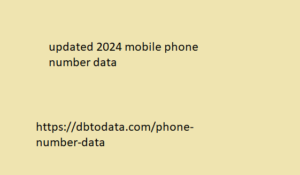Today’s post is by ProBlogger Writing Expert Ali Luke
The most important words in your america phone number post are the 6–10 words in the title (also known as the headline).
These words determine whether or not the rest of your post ever gets read. They can guarantee failure, or give your post a great shot at success.
And yet many bloggers treat their title as an afterthought. They either run with the working title they thought up when planning their post, or come up with something half-hearted just so they can publish.
So you can see how much titles matter, let me offer you three different posts. I’ll call them:
- More Reader Engagement
- How to Get More Comments
- Five Ways to Encourage Readers to Comment More Often on Your Posts
Which would you prefer to read?
I’m guessing it’s #3. (Which is, in fact, one of my posts on ProBlogger.) But each title could refer to the same post.
The good news is it’s not hard to get better at writing titles. There are a few straightforward techniques you can use instantly (or with just a little bit of work) to dramatically improve your titles.
Here are my seven favourites:
#1: Be Specific, Not General
A post titled ‘More Reader Engagement’ could mean almost anything. Is it about comments, social media, readers taking action, or what? It’s a general title that could apply to all sorts of posts.
But a post titled ‘Five Ways to Encourage updated 2024 mobile phone number data Readers to Comment More Often on Your Posts’ is clear and specific. If you see that title on Twitter or in your email inbox, you’ll know exactly what you’ll get from that post.
Some bloggers think a vague title will intrigue readers, who’ll then click it to find out what the post is about. The truth is, readers have so many other calls on their time and attention that unless you’re a personal friend they’re probably won’t care enough to click.
#2: Use Numbers Where Appropriate
If you look at any magazine cover, you’ll see that numbers are used prominently.
Numbers are a great form of specificity. A post that promises ‘five ways’ is very different from a post that promises ‘100 ways’.
Here are a few example of how different types of titles could be adapted to include numbers:
How to Set Up WordPress
How to Set Up WordPress in Five Simple Steps
My Top Lessons Learned from My First Year of Blogging
My Ten Top Lessons Learned from My First Year of Blogging
How I Dramatically Increased the Size of My Newsletter List
How I Increased the Size of My Newsletter List by a Whopping 351%
Should You Have Comments On Your Blog?
Should You Have Comments On Your Blog? Four Experts Speak Out
It won’t always make sense to use a number in the title of your post, but quite often it will. Of course, it often makes good sense to use numbers in your post, too. (For more on that, check out How to Use Numbers Effectively in Your Blog Posts.)
#3: Use Powerful Adverbs, Adjectives and Phrases
#6: Use Square Brackets to Add Extra Information
One nifty trick to keep a title short but still give readers an idea of what they’ll be getting is to use square brackets.
You simply add them to the end of your title, like this:
- How to Set Up WordPress in Just 20 Minutes [Video]
- Five Powerful Ways to Start Your Blog Post [With Examples]
- Your Ultimate Guide to Editing Images for Your Blog [Roundup]
There’s no rule about what you can or can’t put in square brackets, though the ones I most often see used are ‘
and ‘[with examples]’. It’s a way to concisely promise an extra benefit and/or of give readers more details about what to expect from your post.
#7: Swipe Other People’s Titles (Then Twist Them)
Finally, one of my very favourite titling tricks (especially if I’m stuck) is to swipe someone else’s title.
Is this legal? Yes, there’s no copyright on titles.
Is it ethical? Yes. I’d avoid doing it if they used a very unusual title format. In most cases, the formula they used for their title is very similar to plenty of other titles out there already. And I’m going to be ‘twisting’ the title anyway.
Here’s a worked example of how you could choose a title and come up with your own spin on it:
Original title: Deadlines – Are they Good or Bad for Your Blogging?
This could become:
Blogging blog: Comments – Are They Good or Bad for Your Blog?
Academic blog: Deadlines – Are They Good or Bad for Your Students?
Small business blog: Email Sign-Up Incentives – Are They Good or Bad for Your List?
Each of these follows the same underlying format as the original (a key word or phrase followed by a dash, then ‘Are They Good or Bad for…’). But each is unique.
Here’s another example:
Original title: 3 Principles of Building an Engaged Blog Audience
This could become:
Parenting blog: 3 Principles of Raising Kind Children
Organisation blog: 5 Key Principles of Organising Your Kitchen
Leadership blog: 7 Principles of Running Engaging Meetings
Go back into your archives and take a edukien marketinerako bideoa: estatistika ikusgarriak look at the titles of three posts from earlier this year. (I suggest you look at these rather than more recent posts so you have some distance from them.)
Would you read those posts if you had only the titles to go on?
Can you spend a few minutes tweaking the titles to make them more compelling? For example, could you add a number or a powerful adjective? (Be careful you don’t change the post URL though, or links to your post will break.)
If you’ve got questions, or you’d like to share your ‘before and after’ versions of your titles, just pop a comment below.

